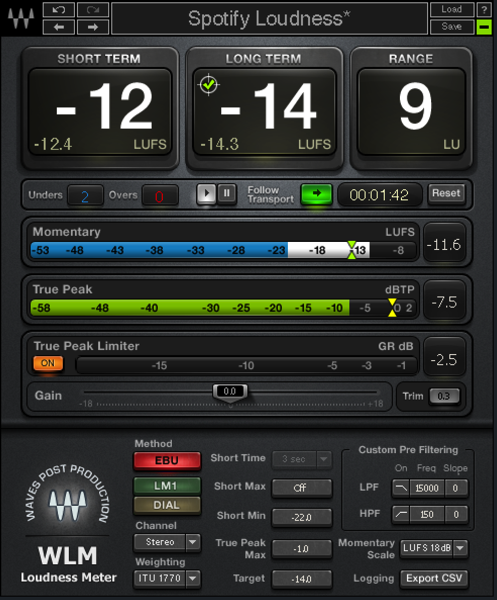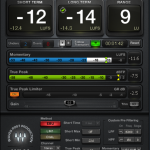
What’s LUFS Got to Do With It? – Part 3
I’ve been writing about using a loudness meter for your broadcast content, and today I’m going to wrap everything up with some advice for using these meters.
When you’re getting started in mixing to a loudness level, it can feel a little bit like walking out on a tightrope especially if you’re doing it as part of a live broadcast. If you’re not careful, you’ll end up chasing your meter which is a bad idea as you’ll quickly discover how difficult this actually is.
One thing I should note is before you even start mixing, sometimes it helps to get your own hearing calibrated to where you’re going to aim your mix for. I have a speech sample from the ATSC that is mixed for their specs so I can put it on anytime and get my ears quickly accustomed to where I’m going to aim. You can currently find that sample HERE.
For a live broadcast or setting up an initial mix, the momentary loudness and short-term loudness readings are my friends. Personally, I use the Waves WLM Plus meter, but you should be able to implement this strategy with most of the loudness meters. On the WLM momentary meter, there is an indicator at my target loudness. Since my final target loudness is going to be an average, with dialogue or speech I try and shoot my level just above that indicator to start. With my calibrated monitors, this typically amounts to pushing up the level to where it is naturally comfortable for me to listen especially if I have just checked things with the ATSC sample.
Once I have my initial level established, I’ll watch the short-term loudness to see if I need to adjust my level a bit. With the short-term loudness, I’m looking to be in the ballpark of my target loudness. The level will often jump around a bit so it’s important not to let that throw you off. What I want is for my level to bounce around the target. If it’s consistently bouncing around at levels lower than the target, I’m going to push it up. If I’m consistently bouncing above the target, I’m going to turn things down. In most cases I’ll hit right in the ballpark, though, because of my calibrated monitors.
After that, the best analogy I’ve heard is to treat the meter like a speedometer. You’re not going to drive your car while staring at the speedometer, but you should glance at it on occasion. Once you’ve got your input at the right loudness level, you should be using your ears to maintain a consistent volume. Give the meter a glance on occasion to make sure you’re still in the zone and not drifting, but you should be able to keep things in the right ballpark naturally barring any wild dynamic swings in the source.
Something to keep in mind is most of the network delivery specs allow for plus or minus 2 dB of the target loudness. So if you’re mixing an online service live to a target of -16 LUFS, that means an integrated loudness of anywhere from -18 LUFS to -14 LUFS is acceptable by broadcast standards. If you miss the target your first couple times out, don’t let that discourage you. Make a note of how far off you were and adjust your monitor level to meet the spec. In other words, if your mix comes out 3 dB below the target, turn your monitors DOWN 3 dB so it forces you to turn things up. If you come out 5 dB louder than the target, turn your monitors UP 5 dB so you don’t mix as loud next time. Measure your monitor levels and keep a log of your monitor levels against your integrated loudness and see how you’re doing.
Now, if you’re working in post, I would still log things and tweak the monitors to get as close as possible to your target loudness on a consistent basis. However, instead of delivering between +/- 2 dB, I would simply adjust the overall level of the mix up or down to export at the target. If you’re bringing things up, just make sure you have a true peak limiter in place. One of the things I like about the WLM Plus meter I use is it has a built-in True Peak limiter. After measuring a full program I can click the Trim button to bring the whole mix up or down to meet the loudness spec.
The final thing I should talk about is if you are broadcasting your FOH mix. If I was trying to get that to meet loudness specs, the first thing I would probably do is record a week or two or three of the raw FOH feed to get an idea of where things are hitting and to make sure it’s a viable mix to being with. I’d want to make sure each part of the service was acceptable and moving from one section of the service to another didn’t result in large volume jumps. With that all worked out, I would measure an acceptable mix with a loudness meter and see where it is in regards to the specs I’m trying to hit. Then I’d simply trim the output level of the overall mix on the console to make up for any difference between where my recorded mixes were and where I wanted to hit. I’d also make sure I had a limiter at the end of the chain before broadcast to protect from any overs. After implementing this, I’d check it over the following few weeks to see where things are hitting and adjust as necessary.
I hope this helps give you an idea of some ways to get started in using a loudness meter. If you’ve got any questions or even your own suggestions, please post them in the comments.


 Previous Post
Previous Post


